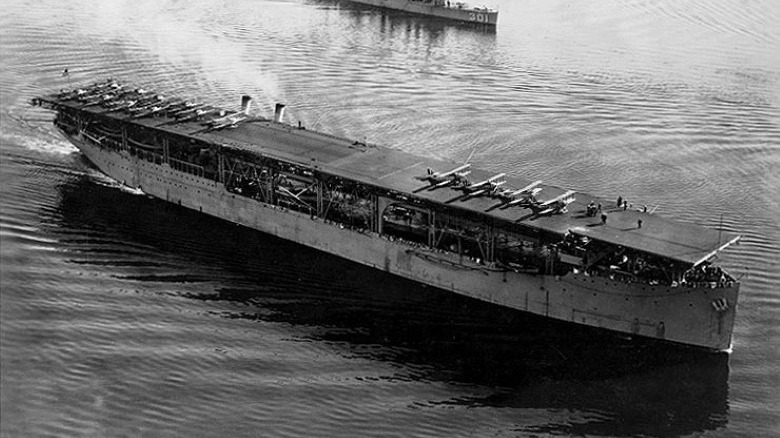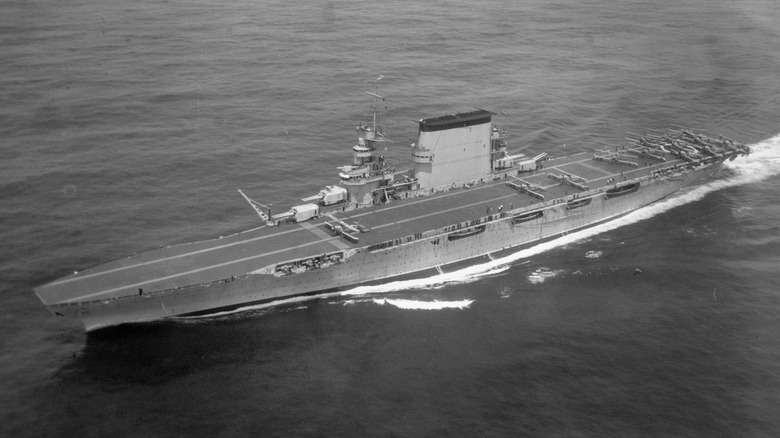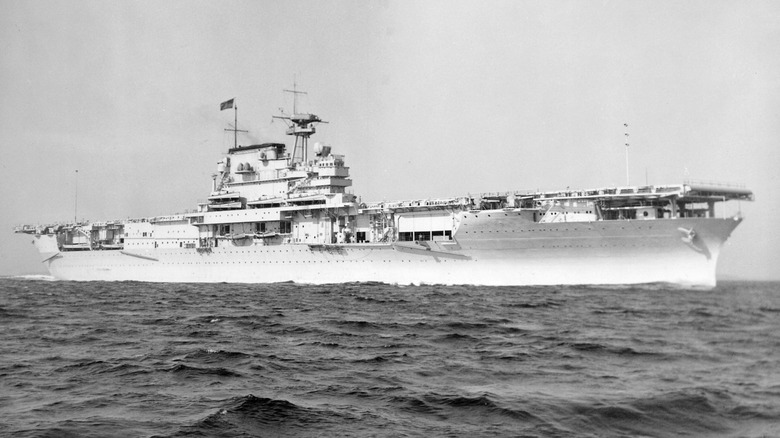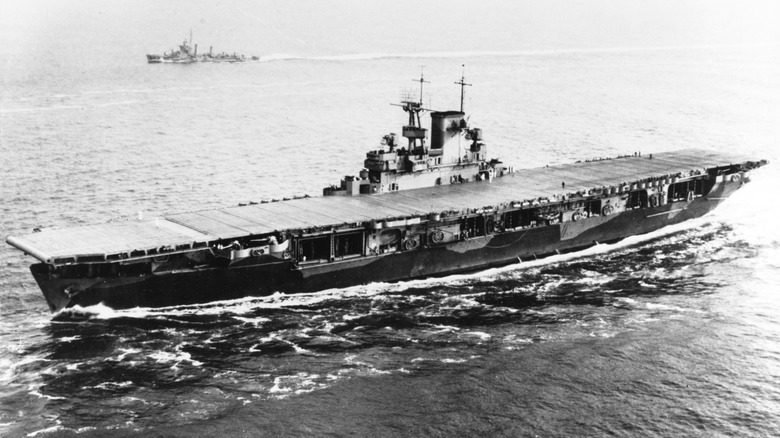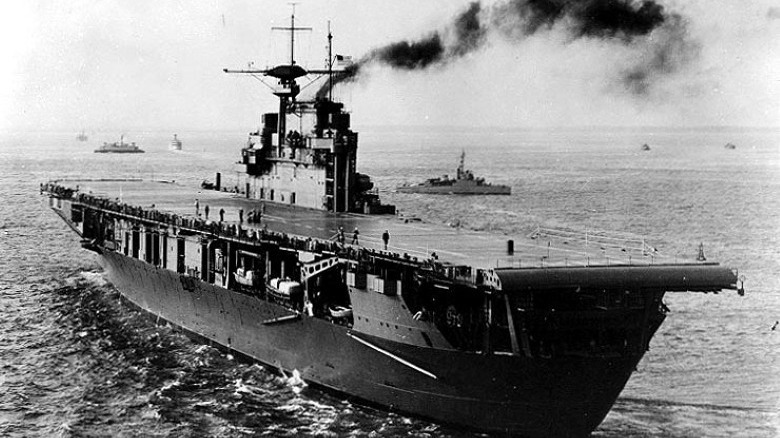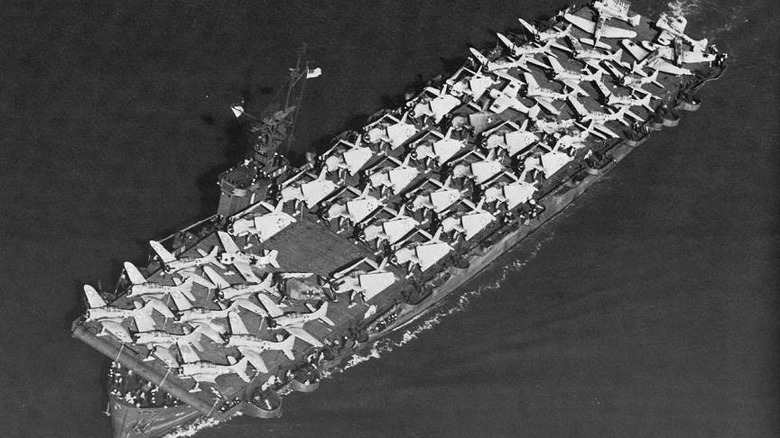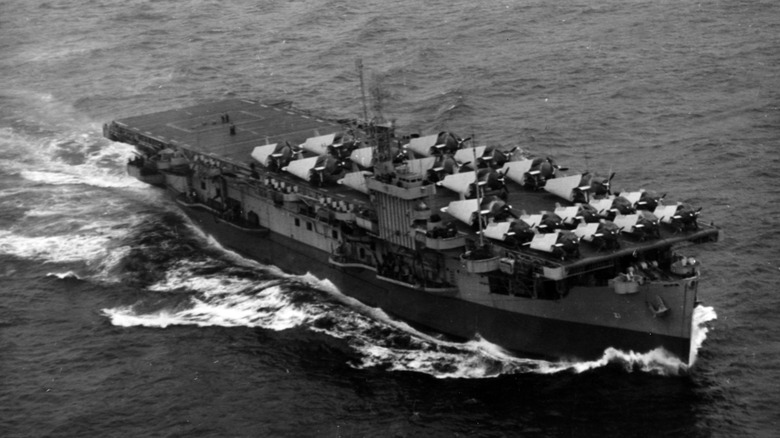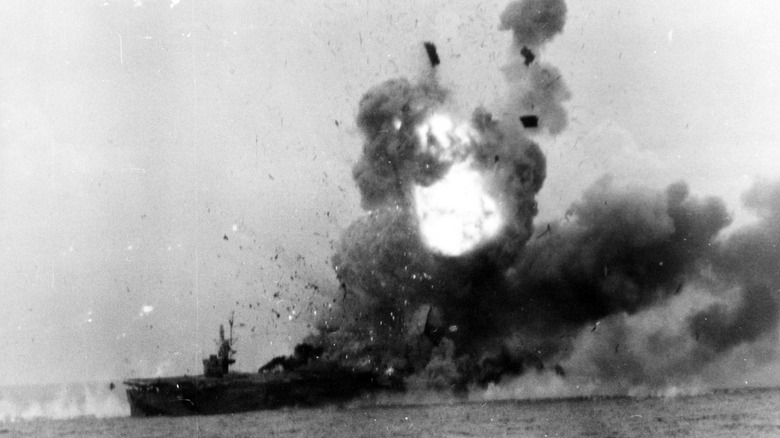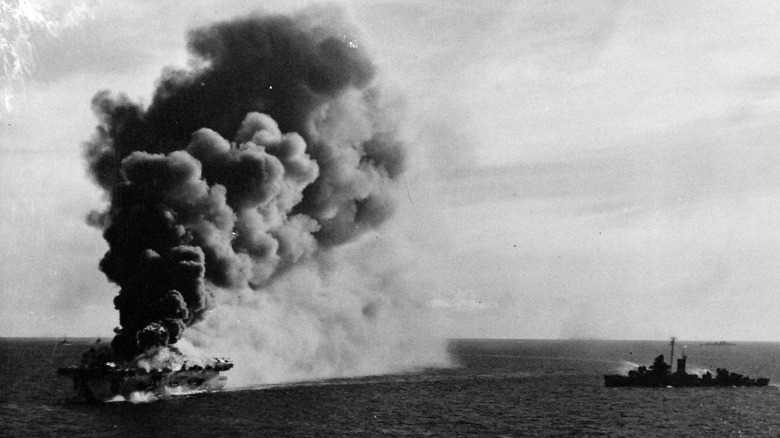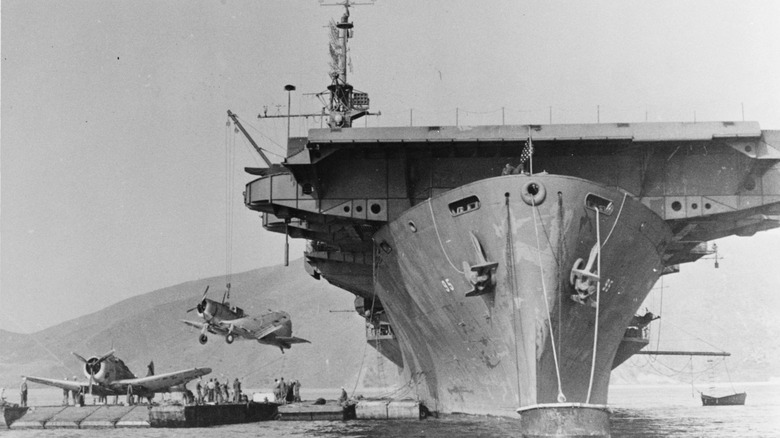Every American Aircraft Carrier Sunk During WWII
World War II was fought across land, sea, and air. Soldiers and tanks battled on the ground, bombers and escort planes struck in the air, and battleships clashed at sea. WWII proved the dominance of air superiority as the key to naval warfare. Over the course of the war, naval combat evolved past the old-fashioned notion of colossal ships broadsiding each other to ships fighting from miles away via aircraft carriers and their fleets of fighter planes and bombers, especially in the early days of the war, when American torpedoes were notoriously unreliable.
At Pearl Harbor, the surprise attack that dragged America into the war, the American Navy was lucky because none of their aircraft carriers were present for the ambush. They were all out on missions at the time. Thus, when Japan awakened the "sleeping giant" of the American war machine, they didn't take out any aircraft carriers, which would prove to be the most valuable type of ship during the conflict. By the war's end, 22 Japanese aircraft carriers would be destroyed, while 12 American aircraft carriers were lost.
Langley
The first American aircraft carrier sunk during WWII was the USS Langley. Originally known as the USS Jupiter, it was a collier ship designed for carrying cargo. In 1920, the ship was converted into an aircraft carrier and renamed Langley. By the start of World War II, however, it was no longer a traditional aircraft carrier, but a seaplane tender, which is more of a support class, carrying bombers.
On February 27, 1942, Langley was attacked 75 miles off the coast of Tjilatjap in Indonesia. The ship was traveling with the USS Whipple and USS Edsall, Destroyer-class ships. With no airborne escort fighter planes to protect it, the Langley was a sitting duck and took multiple hits from Japanese bombers. When it became clear the ship could not be saved, the crew was evacuated, and the ship was scuttled via torpedo strikes from the USS Whipple, not to fall into enemy hands. Japanese ships destroyed the Edsall a few days later, on March 1, 1942, but the Whipple managed to survive the entire war.
Lexington
The USS Lexington, nicknamed "Lady Lex" by the sailors who worked and lived within her steel walls, fought valiantly during the Battle of the Coral Sea. This was one of the first big naval battles of the war and marked the first instance of an aircraft carrier taking on another aircraft carrier, which would become the new status quo of naval warfare during World War II.
Lexington was paired with fellow carrier Yorktown, and together, the two ships managed to take out the Japanese carrier, Shōhō. However, the victory was short-lived, as two bombs and two torpedoes crippled the Lexington. The Yorktown was also damaged but managed to sail back to Pearl Harbor for repairs. In the aftermath of the battle, Lexington had to be evacuated and scuttled, but not before 216 sailors had given their lives for the ship. However, Lexington's sacrifice was not in vain, since the loss of the ship was not as harmful to America as the loss of the Shōhō — as well as damage done to the Shōkaku and the aircraft of the Zuikaku — was to the Japanese. The absence of these ships during the following month's Battle of Midway would prove vital to America's victory in the Pacific.
Yorktown
After barely surviving the Battle of the Coral Sea, Yorktown underwent repairs in time to participate in the Battle of Midway. Unfortunately, the waters surrounding the Midway Atoll would be the Yorktown's final resting place. After taking hits from bombs and torpedoes, the Yorktown was damaged but still fighting. However, in a last-minute surprise torpedo attack from the Japanese submarine I-168, both the Yorktown and USS Hammann were destroyed.
Despite the bitterness of the battle's end and immediate aftermath, the Yorktown was the only American carrier to go down. The Japanese, meanwhile, lost four carriers — a massive victory for the Americans that would resonate for the rest of the war. Midway was a turning point in the Pacific Theater. Thanks to devastating Japanese losses during the battle, America was able to put the Japanese on the back foot for the rest of the war.
Wasp
As the summer of 1942 went on, America and the Allies set their sights on Guadalcanal, seeking a foothold from which to continue the war on land. While the campaign was successful, Operation Watchtower was a costly victory, with thousands of Allied soldiers dying on land, in the sea, and in the air, and not just to combat, but to disease and excruciating heat. However, the outcome was that the Japanese were on the defensive. From here, it would be a slow, brutal, "island hopping" march towards mainland Japan, and the Japanese would make the Allies pay for every step in blood.
On September 15, 1942, the aircraft carrier USS Wasp was critically damaged by a torpedo attack from the Japanese submarine I-19, killing 176 sailors. Unable to be salvaged, the survivors were evacuated, and the ship was scuttled and sent to the bottom of the ocean. The wreck of the Wasp would remain hidden until January 14, 2019, when it was discovered by the research ship, Petrel. While the I-19 managed to survive the Guadalcanal campaign, it would ultimately be destroyed in 1943, falling victim to a depth charge set by the USS Radford, with all 105 hands lost.
Hornet
The USS Hornet played a critical role in America's war in the Pacific. It was the ship from which the Doolittle Raid on Tokyo was launched on April 18, 1942. A symbolic victory, the raid was akin to a "warning shot," signaling to the Japanese that America was not out of the fight and would not back down from the threat of the Empire. The Doolittle Raid came at great cost to the Chinese locals who aided James Doolittle's team in their escape from enemy territory. In retaliation, the Japanese executed as many as 250,000 innocent Chinese civilians.
The Hornet went on to fight at Midway before meeting its final fate at the Battle of the Santa Cruz Islands as part of the Solomon Islands Campaign. While Hornet's planes were out taking down the Shōkaku (they damaged but ultimately did not destroy the Shōkaku, which would survive until the Battle of the Philippine Sea in 1944), the Hornet itself took devastating damage from enemy bombs and torpedoes. U.S. attempts to scuttle the Hornet failed, and she sank the following day, October 27, 1942, after Japanese submarines torpedoed her, finally sinking the once-mighty warship for good.
Liscome Bay
Following the sinking of the USS Hornet, it would be more than a year before another American aircraft carrier would be destroyed. That day would come on November 24, 1943, and the unlucky ship would be the USS Liscome Bay, a heavily armored escort carrier that nevertheless fell victim to a torpedo attack. A total of 77 escort carriers were commissioned during the war, but only six would fall in battle. That's a strong survival rate, but there are always outliers, and few outliers are as tragic as the Liscome Bay.
During the Battle of Makin, the Japanese submarine I-175 launched a salvo of torpedoes at the Liscome Bay, catching the ship off guard. Only one torpedo hit, but it struck the perfect spot, detonating the ship's bombs and killing countless crew members instantly in a massive and horrific explosion. It only took 23 minutes for the ship to sink, and 644 men lost their lives in the process. USS Charrette and USS Fair avenged their deaths during the Kwajalein Invasion on February 4, 1944, destroying the I-175 with depth charges and "Hedgehog" projectiles.
Block Island
So far, we've only covered the war in the Pacific against the Japanese military. However, there was a single American aircraft carrier, the USS Block Island, that was destroyed by Nazi Germany on the European front. The Block Island was sent on missions to take down German U-boats that were attacking supply ships, and managed to sink no fewer than two enemy vessels before switching from hunter to hunted.
On May 29, 1944, the Block Island was sunk by the German U-boat, U-549, which also damaged the destroyer, USS Barr. Fortunately, the casualties weren't nearly as bad as they could have been. The USS Ahrens rescued 671 survivors from the Block Island, though 13 crew members and pilots were reported killed or missing in the aftermath of the sinking. The perpetrator, U-549, wasn't so lucky. The Ahrens and the USS Eugene E. Elmore finished the Block Island's mission: they found and destroyed the German submarine, killing all 58 Germans aboard.
Princeton
The Battle of Leyte Gulf was the biggest naval battle of World War II, though it was really split into four main battles that combined to make up the greater whole. Nevertheless, it was an American victory, but one that came at great cost, with over 16,000 Allied soldiers giving their lives between October 23 and October 26, 1944.
One light carrier that was lost during the Battle of Leyte Gulf was the USS Princeton, which fell prey to a Japanese dive bomber. Sometimes, all it takes is a single bomb to trigger a chain reaction that can bring down a mighty aircraft carrier. This was the case with the Princeton, as the Japanese bomb caused the American bombers onboard the carrier to ignite and explode, tearing the ship apart and rendering it unable to be saved. All told, 347 crewmen of the Princeton were killed that day, many of whom died after being rescued by the light cruiser USS Birmingham, which was also destroyed during the battle. After the Princeton was evacuated, it was scuttled, destroyed by the USS Reno to avoid Japanese capture.
St. Lo
Elsewhere during the Battle of Leyte Gulf, Allied and Japanese forces squared off at the Battle off Samar, one of the battle's most visceral pockets of fighting. It was during this clash that the increasingly desperate Japanese air force used suicide bombing not as a last resort sacrifice but as an actual military policy.
The USS St. Lo was christened just two weeks earlier before it received a fatal double hit. A Japanese kamikaze pilot bombed the ship and then crashed into the flight deck, causing irreparable damage. The ship sank in just 30 minutes, the first of many American ships to be destroyed by kamikaze fighters in the final year of the war. Kamikaze attacks would be a scourge on American forces for the remainder of the war, particularly during the Battle of Okinawa, though the terror of these fanatical attacks did little to slow Allied victory in August 1945.
Gambier Bay
The Gambier Bay was also lost during the Battle off Samar. The ship was lost not to dive bombers or torpedoes but to sustained fire from the eight-inch guns of enemy cruisers, which overwhelmed the ship from all directions. When the ship capsized, it sank evenly, straight down, due to the damage being equally distributed across the ship, including shelling from the mighty battleship, Yamato, the largest and most powerful battleship ever built — a record that stands even to this day.
The day she sank, the Gambier Bay carried 900 men on board, with 131 dying during the battle. While the Gambier Bay was destroyed, the Battle off Samar was an American victory, with the Japanese Navy ultimately being pushed back. While the Yamato survived, its equally powerful sister ship, Musashi, was destroyed in the Battle of the Sibuyan Sea, another of the smaller battles that made up the larger Battle of Leyte Gulf. The loss of the Musashi was a massive blow to Japanese firepower, as well as a symbolic victory for the Allies. As for the Yamato, it would be destroyed in April 1945, en route to participate in the Battle of Okinawa.
Ommaney Bay
On January 4, 1945, Japanese forces intercepted the USS Ommaney Bay as it sailed across the Sulu Sea; a single kamikaze strike was enough to sink her. The Japanese pilot slammed his twin-engine plane into the side of the ship, detonating the airplane's onboard bombs and dealing damage that could not be repaired.
There were more than 800 people aboard the Ommaney Bay, and 95 died during the attack. Perhaps more could have been saved, but the nearby USS Burns was wary of getting too close to the flaming wreck of the Ommaney Bay, since there was fear that the ship's torpedoes could explode at any moment, potentially damaging the Burns if it was too close. All in all, the rescue operation took two hours, after which the surviving ship launched a torpedo at the Ommaney Bay, scuttling it so the wreckage could not be salvaged by the enemy.
Bismarck Sea
The final American aircraft carrier lost during World War II was the USS Bismarck Sea, which went down during the Battle of Iwo Jima on February 21, 1945. To date, it's the last American aircraft carrier to be lost in combat.
During the Battle of Iwo Jima, a Japanese kamikaze fighter crashed into the USS Bismarck Sea, causing serious but survivable damage. However, a second kamikaze plane crashed into the ship, likely attracted by the fire from the initial crash, and the Bismarck Sea was dead in the water. The Bismarck Sea carried over 900 crew members, and 318 of them died in the attack. Many of the sailors were killed after abandoning ship, hunted by Japanese fighter planes performing strafing runs, looking to rack up kills even after their enemy was incapacitated and unable to fight back.
While the Bismarck Sea was destroyed, the Battle of Iwo Jima was a hard-fought victory for the Allies, who lost thousands of soldiers in an effort to secure a tiny island on the way to mainland Japan.

